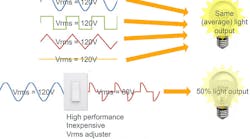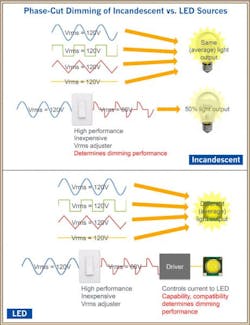Solid-state lighting (SSL) differs from conventional lighting in that it uses light-emitting diodes (LEDs) instead of filaments, plasma, or gases. Although still relatively early in its development, SSL has become competitive in many markets and is expanding into others as the technology continues to improve. But in the process, it’s encountering a number of important issues that need to be addressed, one of which is dimming.
Many people think of SSL as being fully dimmable, an expectation that gets reinforced to varying degrees by manufacturer claims. In theory, LEDs are easily and fully dimmable, because — unlike some other kinds of light sources — there’s nothing inherent in their makeup that would impede the dimming process. On top of that, LEDs typically maintain their efficacy when they’re dimmed, and sometimes even increase it — whereas incandescent sources become less efficacious when dimmed.
Acting up instead of dimming down
However, as we all know, theory doesn’t always hold up out there in the real world — where the rubber meets the road. When installed, the actual dimming behavior of many LED lighting products (their reputation notwithstanding) leaves a lot to be desired. While dimming performance varies significantly across many types of commercially available LED sources, less-than-ideal behavior shows up most frequently when integral LED replacement lamps are installed on circuits controlled by phase-cut dimmers.
This misbehavior runs the gamut of quirkiness. Some products won’t dim at all — a limitation that may or may not be clearly disclosed on product packaging. Others may exhibit what’s known as “dropout,” where they only dim part of the way down to zero light output — say, to 60% of maximum — instead of all the way from 100% down to 1% or below, the way incandescent lamps do. Still others may dim in an abrupt or “staircase” fashion, instead of dimming smoothly and continuously as most of us are used to. In the worst case, users may experience the exasperating phenomenon known as “dead travel” — where the dimming slider or knob moves a certain distance without any noticeable change in light output at all.
And that’s not the end of the possible shenanigans. Some LED lighting products may also demonstrate a “pop-on” phenomenon, whereby a light source that’s been turned off in a dimmed state doesn’t “remember” the dimmed setting. Instead, it initially reverts to full light output when it’s turned back on or, worse yet, requires the user to raise the dimmer setting above some threshold before the light will “pop on.”
Then there are the distracting noises that can accompany the dimming of LED light sources, not to mention the perceptible flicker that can also occur. Even the most basic function a lighting control performs — turning the light source on and off — is not immune to unwanted effects. When some LED light sources are put in the “off” state by some phase-cut dimmers, they may exhibit a variety of unexpected and unwanted behaviors, including: “flashing,” where the light source flashes repetitively; “ghosting,” when the unwanted light is faint but steady; or even “popcorning,” in which different lights on the dimmed circuit flash randomly and asynchronously.
Believe it or not, there is method behind the seemingly random madness of these various dimming problems. Ghosting, for example, occurs mainly with more advanced phase-cut dimmers, where additional functions involve microprocessors or other energy-consuming elements that require a tiny but steady source of current flowing through the light source, even when the lamp is off. While that small amount of current isn’t enough to make a filament glow, it can “fool” some LED lamps into emitting light — an unwanted effect that’s much less likely to occur with dimmers that have a neutral third wire instead of just two live wires.
A question of compatibility
All of these dimming problems can be disconcerting, to say the least. Nevertheless, it’s important to keep in mind that they’re not caused by any shortcomings of SSL technology. Rather, they’re due to the fact that almost all of the existing dimmers in this country were designed for another kind of lighting rather than for LEDs. That is, nearly the entire installed base of traditional line-voltage (phase-cut) dimming controls was designed for incandescent light sources (Figure). Therein lies the rub — there can be compatibility issues between these controls and an LED light source’s “driver,” which converts AC power to low-voltage DC power and maintains a constant current in the LEDs to keep them emitting a steady level of light.
But LED sources are more complex than incandescent bulbs. Incandescent filaments vary only slightly from one product to another, which allows them to interact consistently with different dimmers, all the way down to very low light levels. What’s more, those filaments don’t cool down right away when a phase-cut dimmer removes part of the input AC voltage waveform. As a result, the light they emit doesn’t vary much over the 60-Hz cycle. LED drivers, on the other hand, show considerable variation from one product to the next. In addition, the LEDs themselves react very quickly to changes in current. So even a slight incompatibility with a dimmer — or, for low-voltage circuits, even slight incompatibility with the transformer as well — can significantly affect the light output.
So you can see why it’s so hard to make LED drivers compatible with a wide range of line-voltage dimmers. This difficulty is only compounded by a lack of industry-wide dimming standards. For example, even the term “dimmable” has no universally accepted definition. To fill the void, the industry has adopted “dims like an incandescent bulb” as a de-facto substitute.
The industry is very much aware of the problems associated with dimming LED light sources and is addressing them in a number of ways. For example, for the last four years, DOE has supported efforts led by the National Electrical Manufacturers Association (NEMA) to develop manufacturer dimming guidance and standards for SSL. Most recently, this has focused on the development of NEMA SSL-7, a multi-part global standard for phase-cut dimming of LED lamps. Part A of SSL-7, which will cover compatibility requirements and associated test procedures, will pave the way for the development of Part B, which will cover performance requirements and their associated test procedures.
SSL manufacturers are also looking into the intriguing possibility of bypassing phase-cut dimmers by using alternative approaches to dimming, such as wireless communications networks. Dimming via wireless networks is already addressed by a new standard called the ZigBee Light Link, which was developed by an industry group called the ZigBee Alliance.
See for yourself
At this point in time, however, the most reliable way to tell how an LED light source will behave when dimmed is to actually test it. Otherwise, you might be in for an unpleasant surprise. But to be accurate, such testing should include the whole circuit, not just a single LED source with a single dimmer — because all dimmers have a minimum and a maximum number of LED sources they can effectively operate, and these limits can vary with the make and model of the LED source, the remote driver (where applicable), the dimmer, and (for low-voltage systems) the transformer. What’s more, variations in any part of the system can affect dimming performance, which means that substituting a different lamp, driver, transformer, or dimmer for what was originally specified can lead to dimming problems.
If extensive testing isn’t practical, you should at least test one or two LED light sources before you install more. While not infallible, this will give you a rough indication of how the products are likely to dim. Another option is to consult the database of DOE’s LED Lighting Facts® program, which recently began allowing manufacturers to provide optional links to dimming compatibility information for their products. A growing number of manufacturers are putting together dimming compatibility tables for their products, and including links on LED Lighting Facts will make that information easier to access. (See “Dimming LEDs: A Work in Progress.”)
Although this article focuses largely on what can go wrong, the truth is the outlook for dimming LED light sources is much better now than it was even a year ago — and it’s getting better all the time. For one thing, an increasing number of dimmable LED sources are finding their way onto the market, and manufacturers are also developing new dimmers that perform better with LED products. During this transition period, the best policy with regard to dimming LED lighting is to proceed with caution, ask lots of questions, and do as much testing and verification as you possibly can.
Brodrick, Ph.D., is the solid-state lighting portfolio manager for the U.S. Department of Energy, Washington, D.C. He can be reached at [email protected].




